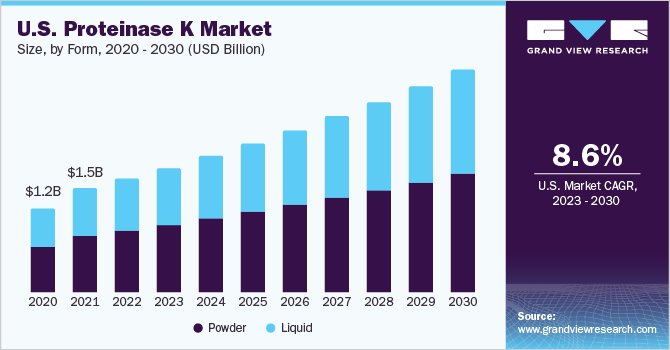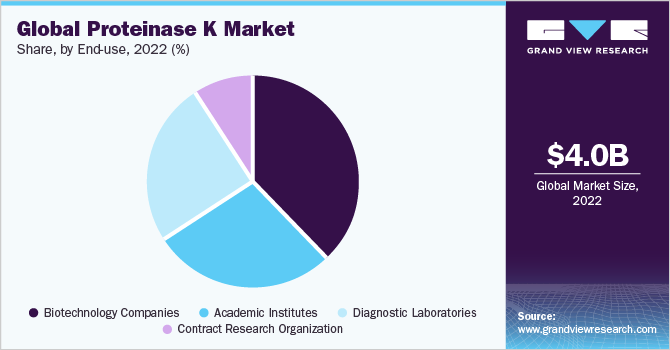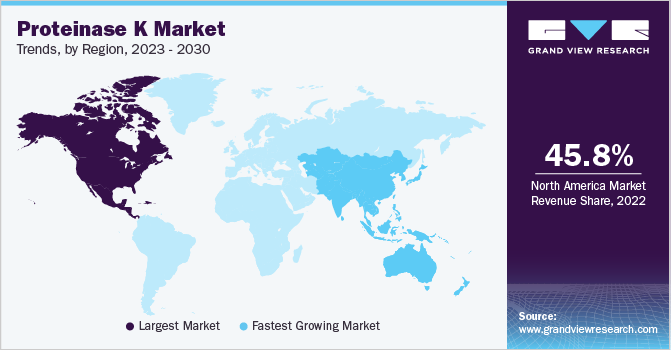- Home
- »
- Clinical Diagnostics
- »
-
Proteinase K Market Size, Share & Growth Report, 2030GVR Report cover
![Proteinase K Market Size, Share & Trends Report]()
Proteinase K Market Size, Share & Trends Analysis Report By Form (Powder, Liquid), By Therapeutic Area (Infectious Diseases, Neurology, Oncology, Cardiology), By Application, By End-use, By Region, And Segment Forecasts, 2023 - 2030
- Report ID: GVR-4-68039-172-8
- Number of Report Pages: 150
- Format: PDF, Horizon Databook
- Historical Range: 2018 - 2021
- Forecast Period: 2023 - 2030
- Industry: Healthcare
Report Overview
The global proteinase K market size was valued at USD 4.0 billion in 2022 and is anticipated to grow at a compound annual growth rate (CAGR) of 8.7% from 2023 to 2030. Increasing implementation of cell separation techniques by cell banks, diagnostic labs, and research laboratories and institutions is one of the key factors likely to contribute to the market's growth in the forecast period. Academic institutions are actively seeking innovation in cell separation and sequencing samples. For instance, in April 2022, researchers from Cornell University established a startup Inso Biosciences, to market patented nucleic acid extraction and sample preparation technology. The new technology can complete sample processing in 30 to 40 minutes instead of 6 hours for the length of DNA pieces from 40 kb to 50 Kb.

Moreover, the rising demand for proteinase K in POC diagnostics applications is likely to fuel market growth. Numerous smartphone-based POC devices and related tools have developed as next-generation POC diagnostics or testing devices, thus enhancing market growth. For instance, ACMC platform-based smartphone application integrates with the autonomous capillary microfluidic chip for cardiac troponin I in myocardial infarction testing. This platform can be easily used in developing economies, where resources are scarce. Thus, innovative technological advancements in POC devices are anticipated to drive the market further.
The market is driven by the broad applications of molecular diagnostic techniques and their associated enzymes for IVD. Recombinant proteinase K from tritirachium is used for nonspecific digestion in diagnostics and NGS-grade applications, which need limited residual DNA content. Proteinase K can be used as a supplement in molecular diagnostic applications, such as NGS and PCR. NGS is expected to witness the increasing adoption of personalized medicines and other clinically developed therapies. Targeted panels and gene expression profiling via qPCR remain the two most common uses for NGS sequencers in a pathology lab. In addition, the decline in the cost of sequencing has broadened the use of NGS technologies. Therefore, increasing demand for NGS diagnostic techniques is anticipated to increase the uptake of proteinase K in the coming years.
Furthermore, the COVID-19 pandemic boosted the demand for proteinase K, exponentially propelling the market's growth. Proteinase K is widely employed in extraction protocols of genetic material. It is important since it can absorb proteins that eliminate cross-contamination from nucleic acids. According to a study published on PLOS in March 2021, proteinase K treatment, followed by thermal shock for RNA extraction of COVID-19, is faster and relatively cost-effective. In addition, companies were using proteinase K to develop kits for COVID-19 diagnostics. For instance, the U.S. FDA granted EUA to the Coronavirus Nucleic Acid Detection Kit by PerkinElmer, an RT-PCR using saliva samples to assess patient conditions. These steps to develop COVID-19 diagnostic kits and associated enzymes positively impacted market growth.
Form Insights
Based on forms, the market is segmented into powder and liquid. The powder segment accounted for the largest revenue share of 53.7% in 2022. The segment's growth can be attributed to the benefits offered by this technique. The powder form of proteinase K is ready to use and has numerous advantages, such as long shelf-life, inexpensive shipment, and high stability. In addition, powder form does not reduce the activity of proteinase K. It is stable to transport through the ship with no prerequisite in terms of temperature conditions, thus cutting down the extra cost for ice-pack shipment. These advantages of powder form are increasing its applications, thereby contributing to market growth.
The liquid segment is expected to grow at the fastest CAGR of 9.0% during the forecast period. Under various circumstances, the liquid form of proteinase K is preferred over the powdered form. The liquid form is relatively more convenient to boil down. In addition, it is a time saver as the solution is ready to use, and thus no time is required for solubilizing. Importantly, there is a lower risk of contaminating proteinase K, which would harm the RNA or DNA samples. Therefore, such advantages of liquid form aid in large batch production, which is expected to fuel market growth during the forecast period.
Therapeutic Area Insights
Based on the therapeutic area, the market is segmented into infectious diseases, diabetes, oncology, cardiology, nephrology, autoimmune diseases, neurology, and others. The infectious disease segment accounted for the largest revenue share of 31.4% in 2022. The increasing incidence of infectious diseases such as HIV, tuberculosis, and malaria in low- to mid-income countries is anticipated to encourage players to develop products that are easy to operate in a low-resource setting. For instance, QIAGEN offers QIAGEN Proteinase K, which is isolated from the saprophytic fungus Tritirachium album and is a subtilisin-type protease. The product is used to isolate DNA and RNA from the samples during viral and bacterial infection diagnosis. Hence, the presence of proteinase K in rapid molecule testing is expected to accelerate market growth.
The neurology segment is estimated to register the fastest CAGR of 9.4% over the forecast period. Various therapies for neurology are under development, such as small molecule therapies, enzyme replacement, gene editing, splicing, and gene-replacement therapies with adeno-associated vectors. In addition, gene expression profiling is considered to be an important tool for identifying diagnostic and therapeutic targets in neurological diseases. Proteinase K is used during the extraction process as it enhances the RNA yield and makes the majority of samples eligible for array analysis. Innovation in therapies is one of the key drivers for the market.
Application Insights
Based on application, the market is segmented into contract research organizations, academic institutes, biotechnology companies, and diagnostic laboratories. The biotechnology companies segment held the largest revenue share of 38.1% in 2022 and is expected to grow at the fastest CAGR of 9.7% over the forecast period from 2023 to 2030. An increase in the application of in situ hybridization (ISH) techniques to support clinical and preclinical studies for biotechnology companies is expected to drive segment growth. ISH staining, tissue sectioning, high-resolution full-slide scanning, scoring, and image analysis are ISH protocols implemented by these entities. Implementation of ISH protocols fuels using a proteinase K enzyme to digest tissue samples during ISH.
The academic institute's segment is expected to grow significantly during the forecast period. Academic laboratories offer integrated services for every IVD clinical research stage, from its development to commercialization. In addition, several collaborations for developing new technologies with other academic and industrial agencies for developing clinical trial procedures, such as expert review of biopsy histopathology or cytology. Such reviewing of histology assays by academic laboratories involves the usage of proteinase K enzyme for the digestion of tissue samples, thereby driving its usage rate in academic laboratories.
End-use Insights
Based on end-use, the market is segmented into isolation and purification of genomic DNA and RNA, in situ hybridization, and mitochondria isolation. The isolation and purification of genomic DNA and RNA segment held the largest revenue share of 60.0% in 2022 and is expected to grow at the fastest CAGR of 9.3% over the forecast period. Proteinase K is used at multi-stages in the genomic DNA and RNA purification process. Before initiating the process, it is stored at -20°C. Under the stage of sample lysis, it is used for cultured cells, mammalian whole blood (non-nucleated), animal tissue, and nucleated whole blood. The isolation and purification of genomic DNA and RNA have become routine in CROs and biotechnology companies. With the emerging need for personalized treatment in cancer and rare diseases, the demand for DNA or RNA isolation is anticipated to witness upward trends, and similar trends will be reflected in the market.

The in-situ hybridization segment is expected to expand at a lucrative CAGR during the forecast period. The increasing adoption can be attributed to associated benefits such as high-volume testing and automated devices that facilitate tests faster and more accurately. The increasing incidence of diseases associated with chromosomal aberrations, such as genetic abnormalities and cancer, coupled with unmet diagnostic and clinical needs, is expected to be a high growth-rendering factor for this segment.
Regional Insights
North America dominated the market and accounted for the largest revenue share of 45.8% in 2022, owing to the high demand for proteinase K and the increasing prevalence of infectious disorders in the region. To combat the COVID-19 pandemic, the FDA issued Emergency Use Authorizations (EUA) for in vitro COVID-19 laboratory-developed tests. In addition, most of these EUAs had been for enzyme-linked immunosorbent assay and reverse transcription polymerase chain reaction (RT-PCR)-based tests for detecting SARS-CoV-2. Owing to the high applications of enzymes during RT-PCR, such developments help generate revenue in the North American market.

Asia Pacific is expected to grow at the fastest CAGR of 11.3% during the forecast period, owing to increasing applications of sequencing technology coupled with various government initiatives to promote genomics research and precision medicine. For instance, in 2020, the government of Singapore launched the National Precision Medicine (NPM) Strategy to analyze better how phenotypic, genomic, clinical factors and lifestyle factors affect the health of Singapore citizens. Such government initiatives are expected to increase proteinase K applications during the region's forecast period.
Key Companies & Market Share Insights
Key players in themarket are adopting various organic and inorganic strategies such as partnerships, mergers and acquisitions, joint ventures, new product developments, and regional expansion to expand their market presence. For instance, in May 2023, QIAGEN announced introducing its portfolio of high-quality enzymes as individual products, aiding industrial customers and researchers globally. This step is anticipated to make QIAGEN a one-stop solution for all research needs. In addition, in December 2022, ArcticZymes Technologies announced that they had upscaled the production of their ArcticZymes Proteinase. The upscaled production is anticipated to meet the increasing industry demand for proteinase. The company also launched a glycerol-free formulation of the proteinase.
In February 2022, Merck KGaA completed the acquisition of Exelead and announced plans to invest approximately USD 542 million for scaling up its technology. The initiative is expected to broaden the company’s portfolio of offerings and can positively affect its growth. In addition, in April 2022, Thermo Fisher Scientific, Inc. collaborated with Matrix Clinical Trials to enhance its clinical research solutions and boost its market prospects for decentralized trial solutions and associated products. The following are some of the major participants in the global proteinase K market:
-
Merck KGaA
-
QIAGEN
-
Thermo Fisher Scientific, Inc.
-
F. Hoffmann-La Roche Ltd
-
Abcam plc.
-
Agilent Technologies, Inc.
-
Biocatalysts
-
Minerva Biolabs GmbH
-
Promega Corporation
-
Takara Bio Inc.
-
New England Biolabs
-
MP BIOMEDICALS.
Proteinase K Market Report Scope
Report Attribute
Details
Market size value in 2023
USD 4.4 billion
Revenue forecast in 2030
USD 7.8 billion
Growth rate
CAGR of 8.7% from 2023 to 2030
Base year for estimation
2022
Historical data
2018 - 2021
Forecast period
2023 - 2030
Quantitative units
Revenue in USD million, and CAGR from 2023 to 2030
Report coverage
Revenue forecast, company ranking, competitive landscape, growth factors, and trends
Segments covered
Form, therapeutic area, application, end-use, region
Regional scope
North America; Europe; Asia Pacific; Latin America; MEA
Country scope
U.S.; Canada; UK; Germany; France; Italy; Spain; Denmark; Sweden; Norway; Japan; China; India; Australia; South Korea; Thailand; Brazil; Mexico; Argentina; South Africa; Saudi Arabia; UAE; Kuwait
Key companies profiled
Merck KGaA; QIAGEN; Thermo Fisher Scientific, Inc.; F. Hoffmann-La Roche Ltd; Abcam plc.; Agilent Technologies, Inc.; Biocatalysts; Minerva Biolabs GmbH; Promega Corporation; Takara Bio Inc.; New England Biolabs; MP BIOMEDICALS.
Customization scope
Free report customization (equivalent up to 8 analyst’s working days) with purchase. Addition or alteration to country, regional & segment scope
Pricing and purchase options
Avail customized purchase options to meet your exact research needs. Explore purchase options
Global Proteinase K Market Report Segmentation
This report forecasts revenue growth at global, regional, and country levels and provides an analysis of the latest industry trends in each of the sub-segments from 2018 to 2030. For this study, Grand View Research has segmented the global proteinase K market report based on form, therapeutic area, application, end-use, and region:
-
Form Outlook (Revenue, USD Million, 2018 - 2030)
-
Powder
-
Liquid
-
-
Therapeutic Area Outlook (Revenue, USD Million, 2018 - 2030)
-
Infectious Diseases
-
Diabetes
-
Oncology
-
Cardiology
-
Nephrology
-
Autoimmune Diseases
-
Neurology
-
Others
-
-
End-use Outlook (Revenue in USD Million, 2018 - 2030)
-
Isolation and Purification of Genomic DNA & RNA
-
In Situ Hybridization
-
Mitochondria Isolation
-
-
Application Outlook (Revenue, USD Million, 2018 - 2030)
-
Contract Research Organization
-
Academic Institutes
-
Biotechnology Companies
-
Diagnostic Laboratories
-
-
Regional Outlook (Revenue, USD Million, 2018 - 2030)
-
North America
-
U.S.
-
Canada
-
-
Europe
-
UK
-
Germany
-
France
-
Italy
-
Spain
-
Denmark
-
Sweden
-
Norway
-
-
Asia Pacific
-
Japan
-
China
-
India
-
Australia
-
Thailand
-
South Korea
-
-
Latin America
-
Brazil
-
Mexico
-
Argentina
-
-
Middle East and Africa
-
South Africa
-
Saudi Arabia
-
UAE
-
Kuwait
-
-
Frequently Asked Questions About This Report
b. Some key players operating in the proteinase K market include Merck KGaA, Codexis, Inc., F. Hoffmann-La Roche Ltd., Amano Enzyme Inc., Advanced Enzymes Technologies Ltd., Biocatalysts Ltd., Amicogen, Dyadic International, BBI Solutions, Affymetrix, and American Laboratories.
b. Key factors that are driving the proteinase K market growth include broad applications of molecular diagnostic techniques and their associated enzymes for IVD, rise in demand of point of care diagnostics coupled with the utility of proteinase K in POC diagnostic tests, and rising incidence of chronic disorders.
b. The global proteinase K market size was estimated at USD 4.0 billion in 2022 and is expected to reach USD 44 billion in 2023.
b. The global proteinase K market is expected to grow at a compound annual growth rate of 8.7% from 2022 to 2030 to reach USD 7.8 billion by 2030.
b. North America dominated the proteinase K market with a share of 45.8% in 2022. This is attributable to owing to well-established healthcare infrastructure, an increase in investments by the public & private sectors in In Vitro Diagnostics (IVD), the high adoption rate of molecular diagnostics, and the presence of a substantial number of market players in this region.
Share this report with your colleague or friend.
![gvr icn]()
NEED A CUSTOM REPORT?
We can customize every report - free of charge - including purchasing stand-alone sections or country-level reports, as well as offer affordable discounts for start-ups & universities. Contact us now
![Certified Icon]()
We are GDPR and CCPA compliant! Your transaction & personal information is safe and secure. For more details, please read our privacy policy.
We are committed towards customer satisfaction, and quality service.
"The quality of research they have done for us has been excellent."





